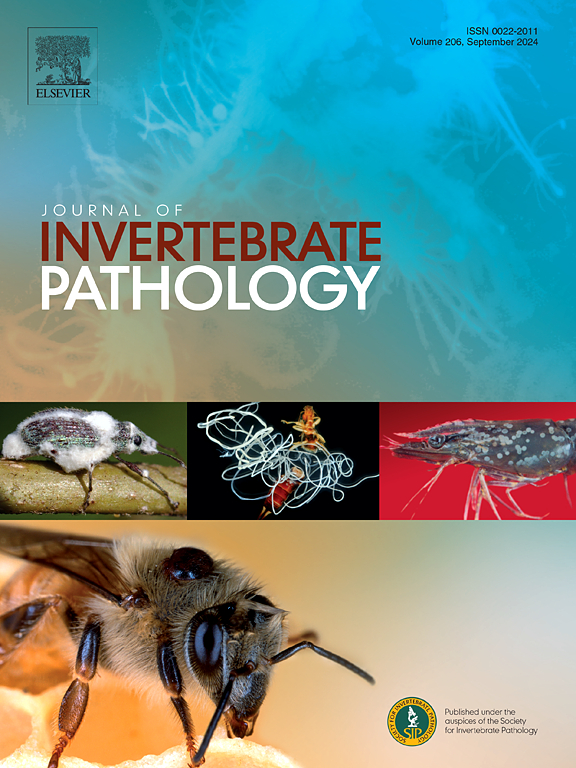Insect-parasitic fungi as a model system to investigate coinfections
IF 2.4
3区 生物学
Q1 ZOOLOGY
引用次数: 0
Abstract
Living organisms are often infected simultaneously by different parasites. The outcomes of such coinfections can be based largely on the identity of the parasites involved, which renders investigation of other variables difficult. Additionally, most coinfection studies use pairs of very different parasites making it even more challenging to investigate any fundamental aspect of coinfection itself. To address this problem, we report here the establishment of a model system composed of two entomopathogenic fungi, Beauveria bassiana and Metarhizium robertsii, and larvae of the beetle Tenebrio molitor to study coinfections. These two fungi interact in a similar fashion with the host and this allows us to examine coinfections experimentally while largely excluding parasite identity and host-exploitation strategy as variables. Coinfection between both fungi in standard conditions – inoculated at the same time and in the same place − did not enhance virulence towards the host, larvae of the beetle Tenebrio molitor. In this scenario, B. bassiana was the dominant fungus, emerging in 60 % of infected larvae, versus M. robertsii in 12 %, and both parasites emerging in 28 %. We then tested if intrinsic aspects of infection – location of infection, order of inoculation and time lag between infections − could modify this outcome. We found that while host virulence was pratically unchanged, parasite fitness was strongly affected by infection-specific variables. When the fungi were inoculated on different parts of the host body and both fungi sporulated, parasite fitness was greatly reduced. Order of inoculation also had an effect on coinfection, with the first parasite to arrive dominating the host, even for M. robertsii which proved to be a weak competitor in simultaneous infection. However, the time lag between infections did not alter this within-host priority effect. Our findings support the use of the proposed system to study coinfections since we can investigate a wide range of environmental and infection factors, including neglected ones, that can alter host and parasite fitness. We intend to generate a body of theory that also can be used in other biological systems that investigate coinfections. These results may also inform the use of these fungi as biocontrol agents in agriculture, given they may be used in conjunction.

昆虫-寄生真菌作为研究共感染的模型系统。
生物体常常同时受到不同寄生虫的感染。这种共感染的结果在很大程度上取决于所涉及寄生虫的身份,这使得对其他变量的调查变得困难。此外,大多数共同感染研究使用非常不同的寄生虫对,这使得调查共同感染本身的任何基本方面更具挑战性。为了解决这一问题,我们建立了由球孢白僵菌和罗伯特绿僵菌两种昆虫病原真菌与黄粉虫幼虫组成的模型系统来研究共感染。这两种真菌以类似的方式与宿主相互作用,这使我们能够通过实验检查共感染,同时在很大程度上排除了寄生虫身份和宿主利用策略作为变量。两种真菌在标准条件下的共同感染——在同一时间和同一地点接种——并没有增强对宿主——黄粉虫幼虫的毒力。在这种情况下,球孢单胞菌是优势真菌,在60% %的感染幼虫中出现,而罗伯氏单胞菌为12% %,两种寄生虫均出现在28% %。然后,我们测试了感染的内在方面——感染的位置、接种顺序和感染之间的时间间隔——是否可以改变这一结果。我们发现,虽然宿主的毒力几乎没有变化,但寄生虫的适应性受到感染特异性变量的强烈影响。当两种真菌分别接种于寄主身体的不同部位,并且两种真菌都产生孢子时,寄生虫的适合度大大降低。接种顺序对共感染也有影响,第一个到达的寄生虫支配宿主,即使对绿僵菌也是如此,它在同时感染中被证明是一个弱竞争对手。然而,感染之间的时间差并没有改变这种宿主内优先级效应。我们的研究结果支持使用所提出的系统来研究共感染,因为我们可以调查广泛的环境和感染因素,包括被忽视的因素,这些因素可以改变宿主和寄生虫的适应性。我们打算产生一个理论体系,也可以用于其他研究共感染的生物系统。这些结果也可能为这些真菌作为农业生物防治剂的使用提供信息,因为它们通常是联合使用的。
本文章由计算机程序翻译,如有差异,请以英文原文为准。
求助全文
约1分钟内获得全文
求助全文
来源期刊
CiteScore
6.10
自引率
5.90%
发文量
94
审稿时长
1 months
期刊介绍:
The Journal of Invertebrate Pathology presents original research articles and notes on the induction and pathogenesis of diseases of invertebrates, including the suppression of diseases in beneficial species, and the use of diseases in controlling undesirable species. In addition, the journal publishes the results of physiological, morphological, genetic, immunological and ecological studies as related to the etiologic agents of diseases of invertebrates.
The Journal of Invertebrate Pathology is the adopted journal of the Society for Invertebrate Pathology, and is available to SIP members at a special reduced price.

 求助内容:
求助内容: 应助结果提醒方式:
应助结果提醒方式:


